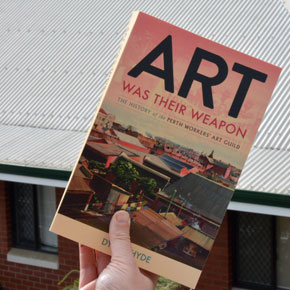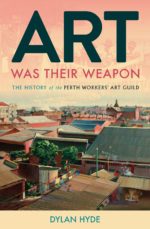Read this and be smarter: The Workers’ Art Guild embraced new ideas at a time when Perth was still an isolated regional city

The Workers’ Art Guild was a radical cultural and political force in Perth in the 1930s and 1940s. The Guild’s innovative approaches to theatre and art were praised by critics, but its left-wing politics, were denounced by many. This extract is from a new book by Dylan Hyde called Art Was Their Weapon.
Six thousand people attended the 1937 West Australian Drama Festival. The Workers’ Art Guild produced two plays for the event — Private Hicks and Hinkemann — which were described by Perth performing arts journal Music and the Drama as ‘characteristic choices’ given that ‘social drama of wide significance is the special field of the Workers’ Art Guild’.
…
The choice of Ernst Toller’s Hinkemann was described by Music and the Drama as the Workers’ Art Guild ‘turning from the “empty trifling” which it sees in old fashioned drama’. The bleak, stark and melancholy two-act play presents an entirely reasonable reflection of its Berlin setting and of the weighty period and matters with which it deals. Clearly Toller had written the play ‘to purge the soul with pity and fear’, and ‘in attending to the souls of his potential audience he has not spared their stomachs’ in ‘swiftly changing scenes of undiluted horror’.
…
About a thousand people attended the Guild’s single heady His Majesty’s Theatre performance of Hinkemann, directed by Keith George, with ‘the breathless stillness of an audience which must have been largely unaccustomed to such devastating frankness’. Again the curtain did not drop between acts, and the audience sat both stunned and mesmerised through nearly two hours of this most powerful and assaulting anti-war play, impressively rendered by the Guild cast.
The large central cast numbered about thirty and, not content with merely playing the expansive stage, George increased the depth by stripping the stage bare, pulling out all scenery and backdrops and dismantling the back facade of the stage to expose the rough brick wall at the back of the theatre. He then ‘piled up any rubbish or anything that was around, and left it in sort of shapes and shadows,’ and played spotlights into ‘the wonderful depth’ from the front to the back of the stage, signalling scene changes by adjustments of colour and shade in the lighting. Not for the first time, George’s sparse set was enhanced by the suggestions of these cunning lighting effects, and ‘a few modernist circus posters formed his only “scenery” .’ Music and the Drama applauded George’s ‘modern production methods’:
‘The different settings were suggested by the barest essentials, which were boldly moved on to the stage between scenes within full view of the audience. There was nothing incongruous in this method, and the settings were thoroughly effective.’
Paul Hasluck wrote in The West Australian that ‘one cannot imagine any better way to play Hinkemann than it was played last night.’ Another article in The West Australian, however, criticised that which Hasluck had found so laudable:
‘There is one school which goes to the … extreme of stripping accessories to bare bones even, indeed, if one bare bone be permitted. The Workers’ Art Guild subscribes to the beliefs of this school … scorning even a back cloth.’
The curtain rose at the beginning of the play on ‘an enormous darkness’, with the exception of a single light shining on a rickety table and chair. Phyllis Harnett, playing the role of Hinkemann’s wife, stood alone on stage, wiping out the inside of a dish with a rag. It was a moment she would remember almost sixty years later as perhaps ‘the most thrilling moment of my life … the depth, the knowledge of what the setting was like, and Keith’s voice.’ Like a sermon from the pulpit, Keith George’s disembodied voice boomed out over the speakers, intoning, ‘We present this play not for your entertainment, but for your chastening!’ followed by an excerpt from Beethoven’s Ninth Symphony, a particular favourite of [writer and Guild founder Katharine Susannah] Prichard’s. This grand sweep was characteristic of George. He also played the tragic figure of Eugene Hinkemann, a German soldier having returned from the Great War, physically emasculated by a bullet, to an impoverished home and a suffering wife, with great ‘stature’. Hinkemann’s wife begins an affair with a neighbour who comforts her after Hinkemann’s return. Illustrating his misfortune, Hinkemann flees to join a circus, unbeknownst to his wife, where he performs as a strongman, biting the heads off live rats to demonstrate his absolute degradation. Attending the circus one night, Hinkemann’s wife and her lover witness Hinkemann’s performance in horror. She and her husband are both driven to suicide.
Bill Irwin found Keith George’s performance as a castrato, singing in a shuddering falsetto, both disturbing and compelling.
‘Holding onto his loins and not being able to walk properly, and then coming out singing like that — it was climactic and terrible!’
Art Was Their Weapon: The History of the Perth Workers’ Art Guild is available in all good bookstores and online.



